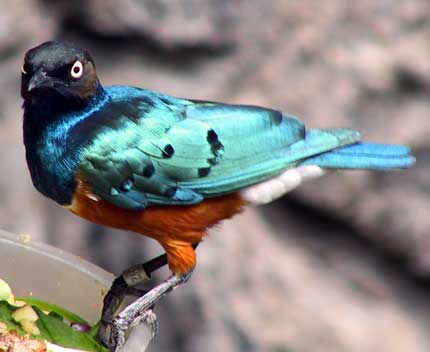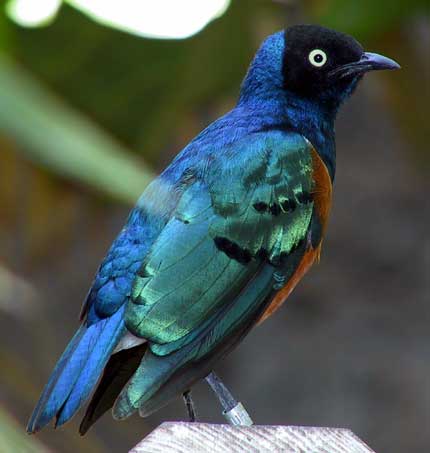tags: researchblogging.org, superb starling, Spreo superbus, Lamprotornis superbus, birds, behavior, infidelity
Superb starling, Lamprotornis (Spreo) superbus.
These small birds are commonly found in open woodlands and savannahs throughout Northeast Africa.
Image: Hogle Zoo, Utah.
While it is widely known that males of many species seek out extra-pair copulations in order to produce as many offspring as possible, the reasons for female "infidelity" are much more complex. For example, a study was recently published that showed how a bird species uses sexual politics to ensure maximal survival of the chicks. In this study, female superb starlings, Lamprotornis superbus, were found to "cheat" on their mates for two main reasons, and the patterns of their "cheating" revealed the underlying reasons for the birds' infidelity.
First, because superb starlings live in cooperative social groups, females will mate with subordinate males from within this social group when they need help raising their chicks. This additional male then also feeds and tends to the nestlings, which increases the chicks' survival rates. Helping raise these chicks with a questionable paternity is a sound evolutionary strategy for males as well as females because females often leave their natal group when they are young and depend upon the social group they integrate into, while most males live their entire lives with their families. Thus, the males in the group are usually related to the chicks, whether they are the father, grandfather, uncle or cousin. By helping all the chicks survive, they help ensure survival of familial genes.
Second, some females seek extra-pair copulations with males outside their group if their mates are too genetically similar to themselves. By mating with outsiders, the females increase their chicks' genetic diversity, even though it does not result in additional help in rearing their chicks. Currently, it is not known how females detect genetic similarities between themselves and their extra-pair mates, but it is thought that other species of birds also use similar mating strategies.
"This is the first study to show that individuals from the same population mate with extra-pair males and gain both direct (like additional helpers) and indirect benefits (like better genes for the offspring), but that they do so in different contexts," said Dustin Rubenstein, a former Cornell graduate student in neurobiology and behavior and now a research associate at the Cornell Laboratory of Ornithology and a Miller Research Fellow at the University of California-Berkeley.
Typically, a male bird who is cuckolded will punish his partner by contributing less than he normally would to raising the chicks, or he will abandon his mate to raise the chicks alone. But because superb starlings are cooperative breeders, the females can mate with other males because even if she is caught doing so, she still can get help raising her chicks from other group members. Interestingly, despite the potential benefits of increased chick-rearing assistance and genetic diversity, female superb starlings are not as promiscuous as most other cooperative breeding birds. This suggests that there may be less conflict between the sexes than in other species, for reasons not yet known.
"In most avian cooperative breeders, 40 to 60 percent of offspring are a result of extra-pair matings, but in superb starlings, only about 14 percent of the offspring are fathered by other males," observed Rubenstein.
With this study and this species, "we can break down the reasons why superb starling females are not faithful to their mates and see that they have different extra-pair mating strategies," explained Rubenstein. "It adds a whole new layer of complexity to the story."
This study will be published soon in the Proceedings of the Royal Society B.
Source
- Log in to post comments



Excellent!
I once had a girlfriend like that.
An excellent article. And those starlings are indeed superb! How come we don't get birds like that around here? Oh right, we have the monk parakeets, except people were stealing them....
Biosparite: It's not particularly uncommon...
Aagh! We're being attacked by an un-closed i tag!
Run away! Run away with emphasis!
Bob
That looks rather like a kingfisher, a similarly sized bird found along wooded riverbanks in western Europe with the same sort of really spectacular electric blue/orange colours.
Kingfishers hunt large water insects. I wonder if these have a similar niche - it would be interesting to know if the colours are a result of convergent evolution.
Alex, it doesn't seem to be like a kingfisher, though it is as colourful.
Diet in Wild:
Insects, berries, human scraps.
Habitat:
Woodland, thorny bush and acacia country as well as in close proximity to human habitation, even within cities.
Another group of colourful birds is the bee eaters, http://www.birdguides.com/species/species.asp?sp=87020 so perhaps the colouration is for sexual attraction; as is the case with the kingfishers I understand.